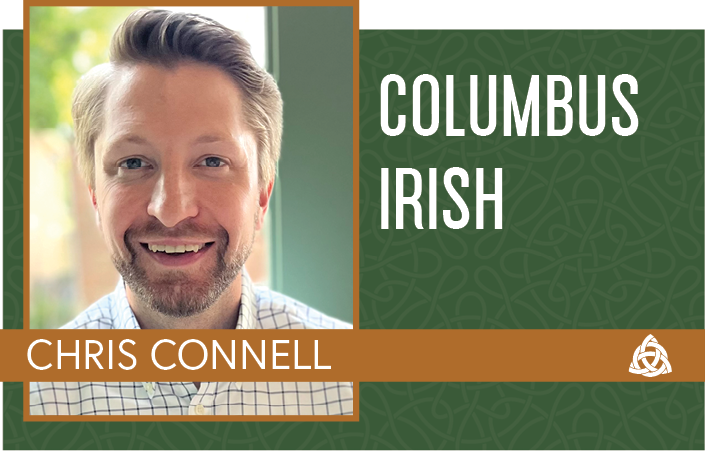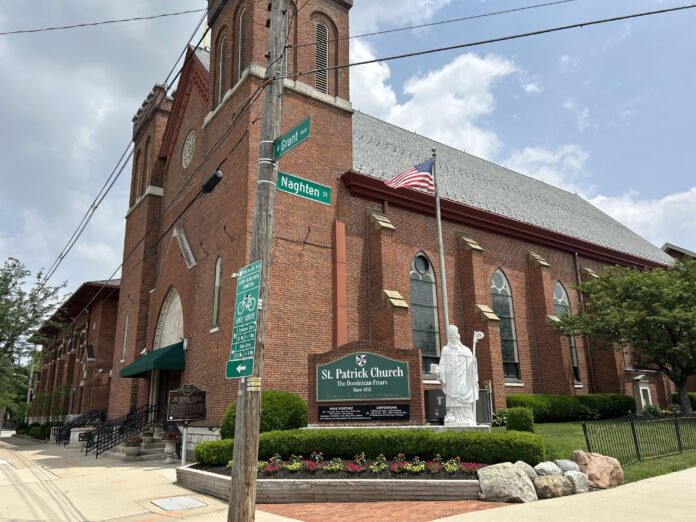
As the samradh (summer) heat bakes central Ohio, it is a great time to wander with the footsteps of the Irish in Columbus’s geography. The Columbus we know started with the grandson of an Irish immigrant, Lucas Sullivant.
In the early 1700s, Lucas’s grandfather, Daniel Sullivan, immigrated from County Cork to Virginia. Upon arrival, Daniel added a “t” to the end of his already-anglicized family name. The book “A Genealogy and Family Memorial,” published by Joseph Sullivant in 1874, says Lucas started “expeditions” westward in Virginia to fight Native Americans as a teenager.
The Lucas Sullivant statue in Genoa Park, Columbus

In the early 1700s, Lucas’s grandfather, Daniel Sullivan, immigrated from County Cork to Virginia. Upon arrival, Daniel added a “t” to the end of his already-anglicized family name. The book “A Genealogy and Family Memorial,” published by Joseph Sullivant in 1874, says Lucas started “expeditions” westward in Virginia to fight Native Americans as a teenager.
He inherited his father’s tobacco farm while a young man and ultimately worked as a land surveyor with “O’bannion, McArthur and others” in the “Virginia Military Land District” (Kentucky, Ohio, and the rest of the Northwest Territories, then still considered Virginia by the British colonists). Lucas Sullivant built his family home just west of the Scioto River in central Ohio, founding the village of Franklinton, where his statue stands today looking at Columbus’s skyline.
John Kerr, born in County Tyrone in 1778 and trained as a lawyer at Trinity College in Dublin, followed Sullivant to Columbus. Kerr was one of four men to petition the Ohio General Assembly to make Columbus the state capitol in 1812. Following the War of 1812, in 1816, Columbus became the state capitol of Ohio, and Kerr was elected its second Mayor, in 1818.
Just north of Franklinton, on the west side of the Scioto River in Franklin County, another Irish land surveyor, John Shields, imprinted Ireland on central Ohio’s landscape through a backroom pub transaction. Shields offered the owner of the Black Horse Tavern and its surrounding farm land free land surveying of his holdings if he would grant Shields “the honor conferred on me to name your village with the brightness of the moon and the beaming of the sun on the hills and dales surrounding the beautiful valley, it would give me great pleasure to name your new town after my birthplace, Dublin, Ireland.” The tavern owner accepted his offer, and, thanks to John Shields, we will celebrate Irish culture and music on August 1-3 this year in Dublin, Ohio at the 38th annual Dublin Irish Festival.
As Famine immigrants spread across America, Columbus only had Holy Cross Catholic Church for them to worship in until 1850. Holy Cross still stands, just north of modern-day German Village in downtown Columbus. German and Irish immigrant worshipers shared Holy Cross until 1850, when competition for service-time between English and German-spoken Mass led to the parish voting to split.

St. Patrick’s Cathedral
Named for Ireland’s patron saint, construction began on St. Patrick’s Cathedral in 1852, and the first Mass was celebrated at St. Patrick’s on September 23, 1853. Today, the Cathedral still sits where the east-west Naghten Street (formerly, “North Public Street”) intersects Grant Avenue.
The original North Public Street encompassed all of modern-day Nationwide Boulevard in downtown Columbus and was colloquially known as “Irish Broadway” by local residents because it connected the homes and businesses of the newly arrived Irish to St. Patrick’s. Naghten Street’s namesake, William Naghten, from County Westmeath, arrived first in New York City in 1849 and then Columbus by 1852, soon taking a job as a carpenter building railroad cars.
Naghten was elected to Columbus City Council in 1863 and was regularly reelected to his Ninth Ward council seat (containing all the city north of North Public Lane). He was elected council president in 1868 and reelected in 1869. In 1869, Columbus City Council honored Naghten by formally re-naming North Public Street to Naghten Street, which still delivers parishioners to St. Patrick’s to this day.
In modern times, the geography of Irish culture in Columbus has shifted south. The Ancient Order of Hibernians, Patrick Pearse Division, operates from Tara Hall, near the Shamrock Club on the city’s Southside. Ahead of the Dublin Irish Festival, it’s the Shamrock Club holding an Irish Music Festival on July 12th, where musicians from Columbus’s Comhaltas organization will take the stage, along with a full lineup of traditional and modern Irish music bands.
The Central Ohio Daughters of Erin organization and the Shamrock Club are both hosting their own fundraising golf outings this month. The modern Irish and Irish Americans of Columbus continue to shape the geography of Central Ohio—which already contains such a proud, prominent, and green hue.




